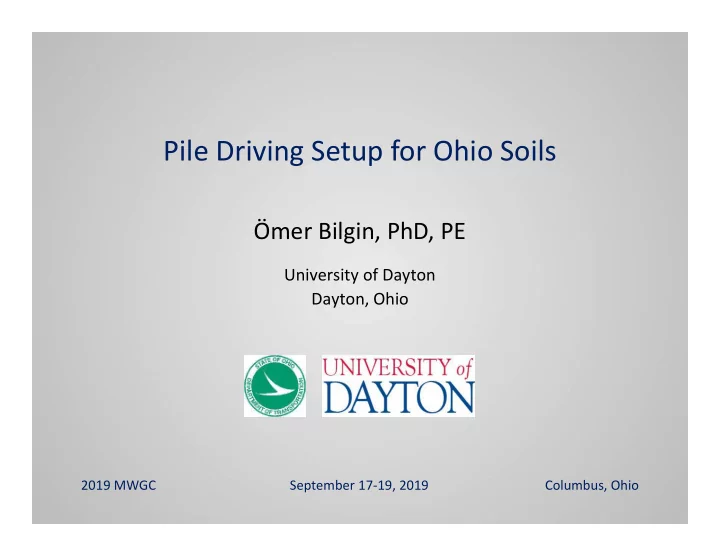

Pile Driving Setup for Ohio Soils Ömer Bilgin, PhD, PE University of Dayton Dayton, Ohio 2019 MWGC September 17-19, 2019 Columbus, Ohio
Motivation for the Pile Setup Research • Pile driving setup is observed in ODOT projects • Setup is rarely considered in ODOT’s current driven friction pile design procedures, as it is not easily: − Predicted, or − Quantified • Substantial driving losses encountered during construction often result in: − Pile driving to halt for a while to determine if setup occurs, − Construction delays, and/or − Unforeseen costs if additional length of pile is driven. 2
Goals and Objectives • Collect data from previous projects where pile setup was observed and restrike data available • Collect pile load test data on active projects in construction • Conduct analysis to investigate the pile setup mechanisms • Correlate pile setup behavior to the properties of soils in Ohio • Formulate pile setup predictions for different geologic conditions and/or geographical locations across Ohio 3
Collecting Data from Previous Projects • Data Sources: ODOT, GRL Engineers, CTL Engineering, and G2 Consulting Group • At the end of data collection: 91 projects / 245 piles Projects Piles 4
Pile Setup Database • Data Sources: ODOT, GRL, and CTL • Number of Projects: 71 (all in Ohio) • Number of Piles: 245 Projects Piles 5
Data Collected • Project Information − County, district, coordinates, and project year • Pile Information − Number, type, size, length, and elevations • Load Test Data − EOID, restrike (total, shaft, and toe) 6
Data Collected (cont’d) • Soil and Groundwater Information − Pile and boring locations − Groundwater elevation − Overall and detailed soil type and layers along pile length − Properties collected SPT-N SPT-N 60 w LL, PL, and PI Fine content (both silt and clay) 7
Project Locations 8
Projects & Piles per County 9
Distribution of Projects & Piles per County 10
Distribution of Dynamic Test Data per County (CASE: 245 / CAPWAP: 166) Note: CAPWAP analysis is the current standard of care (AASHTO LRFD) 11
Maximum Setup Ratio (R = Q(t) / Q EOID ) per County (CASE data) 12
Maximum Setup Ratio (R = Q(t) / Q EOID ) per County (CAPWAP data) 13
Setup Ratio – CASE 14
Setup Ratio – CASE 15
Setup Ratio – CAPWAP 16
Setup Components • Shaft setup • Toe setup/relaxation 17
Pile Lengths 245 piles 18
Pile Types • Pile types in the database: − Cast-in-place pipe pile (CIPP) − Cast-in-place pipe open-ended pipe pile (CIPP-O) − H pile (H) • Other types in the literature: − Concrete, timber, and composite 19
Setup per Pile Types • CIPP, CIPP-O, and H piles 20
Pile Sizes 174 piles 21
Effect of Friction Component 22
Effect of SPT-N value 23
Existing Empirical Model (Skov & Denver, 1988) ( ) Q t t = + A log 1 Q t EOID 0 • Setup Ratio, R • Setup Factor, A = 0.2 for sandy soils = 0.6 for clayey soils • Reference Time, t 0 = 0.5 for sandy soils = 1.0 for clayey soils 24
Next Phase: Field Tests and New Data Collection • Projects with static load test and multiple restrikes • Projects completed: − CUY-21 − CUY-480 • Ongoing projects as part of this research study: − LUC-75 − HAM-75 − SUM-76 25
New Projects: CPT Soundings 26
New Projects – CPT Soundings 27
New Projects – Piezometers 28
New Projects – Piezometers 29
What is Next? • Cluster analysis, based on: − Pile properties − Soil properties − Geographic location • Field tests and new data collection • Combine the data from previous and new projects 30
Example: Hamilton County 31
Acknowledgments • ODOT: • Research Team: − Chris Merklin − Saeed Alzahrani (UD PhD Student) − Alex Dettloff − Matthew Heron (UD MS Student) − Steve Taliaferro − Jamal Nusairat (ELR Robinson) − Steve Slomski − Peter Narsavage (ELR Robinson) − Rick Engel (ELR Robinson) − Robert Liang (UD) − Jerry DiMaggio (ARA) − Jawdat Siddiqi (NEAS) 32
Thank you… Ömer Bilgin, PhD, PE (bilgin@udayton.edu) 33
Recommend
More recommend